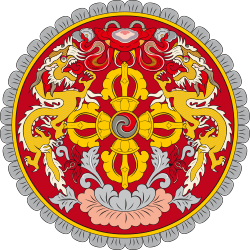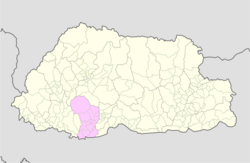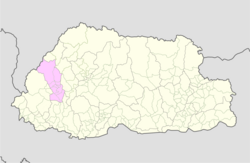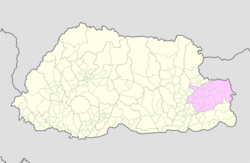Gewogs of Bhutan
 |
|---|
A gewog (
Bhutan comprises 205 gewogs, which average 230 km2 (89 sq mi) in area. The gewogs in turn are divided into
Gewog administration
Under the Local Government Act of 2009, zepa is head of geog each gewog is administered by a Gewog Tshogde (gewog council), subordinate to the Dzongkhag Tshogdu (district council). The Gewog Tshogde is composed of a Gup (headman), Mangmi (deputy), and between five and eight democratically elected Tshogpas from among villages or village groups. All representatives serve five-year terms, unless the local electorate petitions for an election (by a simple majority of the voting population) to vote no confidence in the local government (by at least two-thirds of the voting population). Representatives must be citizens between the ages of 25 and 65, be a resident of their constituency for at least one year, gain certification by the Election Commission, and otherwise qualify under Electoral Law.[8]
While the Gewog Tshogde has powers to regulate resources, manage public health and safety, and levy taxes on land, grazing, cattle, entertainment, and utilities, the gewog administration and all other local governments are prohibited to pass laws. The gewog administration has jurisdiction over roads, buildings (including architecture), recreational areas, utilities, agriculture, and the formulation of local five-year development plans. The Gewog Tshogde also prepares, reports, and expends its own gewog's budget under the supervision and approval of the Minister of Finance.[8]
History
Beginning in the late 1980s, the
In 2002, the Parliament of Bhutan enacted a second, more comprehensive Chathrim (Act) also called the Geog Yargay Tshochung. Under the Geog Yargay Tshochung of 2002, gewog administration included the Gup, Mangmi (deputy), Tshogpa (village or village cluster representative), and the non-voting Chupon (village messenger) and Gewog Clerk. Gup and Mangmi sat for three-year terms while normal representatives sat for one year. The body had a two-thirds quorum requirement, and voted by simple majority. The Chathrim of 2002 empowered gewogs to levy rural taxes, maintain and regulate natural resources, and manage community and cultural life.[6]
The Chathrim of 2002 was superseded by the Local Government Act of 2007, which expanded local bureaucracy and vested more powers in gewog administrators, including enforcement of
Since the Act of 2009, Dzongkhag Thromde Tshogdes, Gyelyong Thromde Tshogdus, and chiwogs have been replaced by thromdes (municipalities) as tertiary administrative divisions. Depending on the population and development of each thromde, it either has an independent bureaucracy ("Class A" Thromdes) or is directly administered by the gewog or dzongkhag ("Class B" and "Dzongkhag Yenlag" Thromdes).[8]
Gewog changes since 2000
In 2002, there were 199 gewogs in Bhutan's 20 dzongkhags;[12] by 2005, there were 205.[13]
In
Since 2005, gewogs and dzongkhags have continued to evolve. On April 26, 2007, Lhamozingkha Dungkhag (subdistrict) was formally transferred from Sarpang Dzongkhag to Dagana Dzongkhag,[14] affecting the town of Lhamozingkha and three constituent gewogs – Lhamoy Zingkha, Deorali and Nichula (Zinchula) – that formed the westernmost part of Sarpang and now form the southernmost part of Dagana.[15]
The gewogs of Bhutan
The following is a list of 205 gewogs of Bhutan by dzongkhag in a chronological order:[16]
| Dzongkhag | Gewog |
|---|---|
Bumthang[17] |
Chhoekhor (1) ཆོས་འཁོར་ |
| Chhume (2) ཆུ་མིག་ | |
| Tang (3) སྟང་ | |
| Ura (4) ཨུ་ར་ | |
Chhukha[18] |
Bjachho བྱག་ཕྱོགས་ |
| Bongo སྦོང་སྒོར་ | |
| Chapcha སྐྱབས་ཆ་ | |
| Darla དར་ལ་ | |
| Dungna གདུང་ན་ | |
| Geling དགེ་གླིང་ | |
| Getana གད་སྟག་ན་ | |
| Lokchina ལོག་ཅི་ན་ | |
| Metakha སྨད་བཏབ་ཁ་ | |
| Phuentsholing ཕུན་ཚོགས་གླིང་ | |
| Sampheling བསམ་འཕེལ་གླིང་ | |
Dagana[19] |
Dorona རྡོ་རོ་ན་ |
| Drujegang འབྲུག་རྗེས་སྒང་ | |
| Gesarling གེ་སར་གླིང་ | |
| Goshi སྒོ་བཞི་ | |
Kana བཀར་ན་ | |
| Karmaling ཀརྨ་གླིང་ | |
| Khebisa ཁེ་སྦིས་ས་ | |
| Lajab ལ་རྒྱབ་ | |
| Lhamoi Zingkha ལྷ་མོའི་རྫིང་ཁ་ | |
| Nichula ནི་ཅུ་ལ་ | |
| Trashiding བཀྲིས་ལྡིང་ | |
| Tsangkha གཙང་ཁ་ | |
Tsendagang བཙན་མདའ་སྒང་ | |
| Tseza བརྩེ་ཟ་ | |
Gasa[20] |
Khamaed ཁ་སྨད་ |
Khatoe ཁ་སྟོད་ | |
| Laya ལ་ཡ་ | |
| Lunana ལུང་ནག་ན་ | |
Haa[21] |
Bji སྦྱིས་ |
| Gakiling དགའ་སྐྱིད་གླིང་ | |
| Katsho སྐར་ཚོགས་ | |
| Samar ས་དམར་ | |
| Sangbay གསང་སྦས་ | |
| Uesu དབུས་སུ་ | |
Lhuentse[22] |
Gangzur སྒང་ཟུར་ |
| Khoma མཁོ་མ་ | |
| Jarey རྒྱ་རས་ | |
| Kurtoed ཀུར་སྟོད་ | |
| Menbi སྨན་སྦིས་ | |
| Metsho སྨད་མཚོ་ | |
| Minjay སྨིན་རྒྱས་ | |
| Tsenkhar སཙན་མཁར་ | |
Mongar[23] |
Balam བ་ལམ་ |
| Chali ཅ་གླིང་ | |
| Chaskhar ལྕགས་ས་མཁར་ | |
| Drametse དགྲ་མེད་རྩེ་ | |
| Drepong འབྲེས་སྤུངས་ | |
| Gongdue དགོངས་འདུས་ | |
| Jurmey འགྱུར་མེད་ | |
| Kengkhar སྐྱེངས་མཁར་ | |
| Mongar མོང་སྒར་ | |
| Narang ན་རང་ | |
| Ngatshang སྔ་ཚང་ | |
Saling ས་གླིང་ | |
Shermuhoong ཤེར་མུ་ཧཱུྃ་ | |
| Silambi སི་ལམ་སྦི་ | |
| Thangrong ཐང་རོང་ | |
| Tsakaling ཙ་ཀ་གླིང་ | |
| Tsamang རྩ་མང་ | |
Paro[24] |
Dokar རྡོ་དཀར་ |
| Dopshari རྡོབ་ཤར་རི་ | |
| Doteng རྡོ་སྟེང་ | |
| Hungrel ཧཱུྃ་རལ་ | |
| Lamgong ལམ་གོང་ | |
| Lungnyi ལུང་གཉིས་ | |
| Naja ན་རྒྱ་ | |
| Shapa ཤར་པ་ | |
| Tsento བཙན་ཏོ་ | |
| Wangchang ཝང་ལྕང་ | |
Pema Gatshel[25] |
Chimoong ཕྱི་མུང་ |
| Chokhorling ཆོས་འཁོར་གླིང་ | |
Chongshing ལྕོང་ཤིང་ | |
| Dechheling བདེ་ཆེན་གླིང་ | |
Dungmaed གདུང་སྨད་ | |
| Khar མཁར་ | |
| Nanong ན་ནོང་ | |
| Norbugang ནོར་བུ་སྒང་ | |
| Shumar ཤུ་མར་ | |
| Yurung ཡུ་རུང་ | |
| Zobel བཟོ་སྦལ་ | |
Punakha[26] |
Barp བརཔ་ |
| Chhubug ཆུ་སྦུག་ | |
Dzomi འཅོམས་མི་ | |
| Goenshari དགོམ་ཤ་རི་ | |
| Guma གུ་མ་ | |
| Kabisa དཀར་སྦི་ས་ | |
| Lingmukha གླིང་མུ་ཁ་ | |
| Shenga Bjemi ཤེལ་རྔ་_སྦྱེ་མི་ | |
Talog རྟ་ལོག་ | |
| Toepisa སཏོད་པའི་ས་ | |
| Toewang སྟོད་ཝང་ | |
Samdrup Jongkhar[27] |
Dewathang དབེ་བ་ཐང་ |
| Gomdar སྒམ་དར་ | |
| Langchenphu གླང་ཅན་ཕུ་ | |
| Lauri ལའུ་རི་ | |
| Martshala མར་ཚྭ་ལ་ | |
| Orong ཨོ་རོང་ | |
| Pemathang པདྨ་ཐང་ | |
| Phuntshothang ཕུན་ཚོགས་ཐང་ | |
Samrang བསམ་རང་ | |
| Serthi གསེར་ཐིག་ | |
| Wangphu ཝང་ཕུག་ |
| Dzongkhag | Gewog |
|---|---|
Samtse[28] |
Dungtoe གདུང་སྟོད་ |
| Dophoogchen རྡོ་ཕུག་ཅན་ | |
Duenchukha བདུམ་ཅུ་ཁ་ | |
| Namgaychhoeling རྣམ་རྒྱས་ཆོས་གླིང་ | |
| Norbugang ནོར་བུ་སྒང་ | |
| Norgaygang ནོར་རྒྱས་སྒང་ | |
| Pemaling པདྨ་གླིང་ | |
| Phuentshogpelri ཕུན་ཚོགས་དབལ་རི་ | |
| Samtse བསམ་རྩེ་ | |
| Sangngagchhoeling གསང་སྔགས་ཆོས་གླིང་ | |
| Tading རྟ་སྡིང་ | |
| Tashicholing བཀྲིས་ཙོས་གླིང་ | |
| Tendruk བསྟང་འབྲུག | |
| Ugentse ཨྱོན་རྩེ་ | |
| Yoeseltse འོད་གསལ་རྩེ་ | |
Sarpang[29] |
Chhuzagang ཆུ་འཛག་སྒང་ |
| Chhudzom ཆུ་འཛོམས་ | |
| Dekiling བདེ་སྐྱིད་གླིང་ | |
| Gakiling དགའ་སྐྱིད་གླིང་ | |
| Gelephu དགེ་ལེགས་ཕུ་ | |
| Jigmechholing འཇིགས་མེད་ཆོས་གླིང་ | |
| Samtenling བསམ་གཏན་གླིང་ | |
| Senggey སེ་ངྒེ་ | |
| Sherzhong གསེར་གཞོང་ | |
Shompangkha ཤོམ་སྤང་ཁ་ | |
| Tareythang རྟ་རས་ཐང་ | |
| Umling ཨུམ་གླིང་ | |
Thimphu[30] |
Chang ལྕང་ |
Darkala དར་དཀར་ལ་ | |
Genye དགེ་བསྙེན་ | |
| Kawang ཀ་ཝང་ | |
| Lingzhi གླིང་གཞི་ | |
| Mewang སྨད་ཝང་ | |
| Naro ན་རོ་ | |
| Soe སྲོས་ | |
Trashigang[31] |
Bartsham བར་མཚམས་ |
| Bidung སྦིས་གདུང་ | |
| Kanglung བཀང་ལུང་ | |
Kangpar རྐང་པར་ | |
| Khaling ཁ་གླིང་ | |
| Lumang ཀླུ་མང་ | |
Merag མེ་རག་ | |
Phongmed ཕོངས་མེད་ | |
Radi ར་དི་ | |
Sagteng སག་སྟེང་ | |
| Samkhar བསམ་མཁར་ | |
Shongphoog ཤོང་ཕུག་ | |
| Thrimshing ཁྲིམས་ཤིང་ | |
| Uzorong ཨུ་མཛོ་རོང་ | |
Yangnyer ཡངས་ཉེར་ | |
| Bumdeling བུམ་སྡེ་གླིང་ | |
| Jamkhar འཇམ་མཁར་ | |
| Khamdang ཁམས་དྭངས་ | |
| Ramjar རམ་སྦྱར་ | |
| Toetsho སྟོད་མཚོ་ | |
Tomzhang སྟོང་མི་གཞང་ས་ | |
| Yalang ཡ་ལང་ | |
Yangtse གཡང་རྩེ་ | |
Trongsa[33] |
Dragteng བྲག་སྟེང་ |
| Korphoog སྐོར་ཕུག་ | |
| Langthil གླང་མཐིལ་ | |
| Nubi ནུ་སྦིས་ | |
| Tangsibji སྟང་སི་སྦྱིས་ | |
Tsirang[34] |
Barshong བར་གཤོང་ |
| Dunglegang དུང་ལ་སྒང་ | |
Gosarling སྒོ་གསར་གླིང་ | |
Kikhorthang དཀྱིལ་འཁོར་ཐང་ | |
| Mendrelgang མནྜལ་སྒང་ | |
Patshaling པ་ཚ་གླིང་ | |
Phuntenchu སྤུང་རྟེན་ཆུ་ | |
| Rangthangling རང་ཐང་གླིང་ | |
| Semjong སེམས་ལྗོངས་ | |
| Sergithang གསེར་གྱི་ཐང་ | |
| Tsholingkhar མཚོ་གླིང་མཁར་ | |
| Tsirangtoe རྩི་རང་སྟོད་ | |
Wangdue Phodrang[35] |
Athang ཨ་ཐང་ |
Bjendag སྦྱེད་ནག་ | |
Darkar དར་དཀར་ | |
| Dangchu དྭངས་ཆུ་ | |
Gangteng སྒང་སྟེང་ | |
| Gasetsho Gom དགའ་སེང་ཚོ་གོངམ་ | |
| Gasetsho Wom དགའ་སེང་ཆོ་འོགམ་ | |
| Kazhi ཀ་གཞི་ | |
| Nahi ན་ཧི་ | |
| Nyisho ཉི་ཤོག་ | |
| Phangyul ཕངས་ཡུལ་ | |
| Phobji ཕོབ་སྦྱིས་ | |
| Ruepisa རུས་སྦིས་ས་ | |
| Sephu སྲས་ཕུག་ | |
| Thedtsho ཐེད་ཚོ་ | |
Zhemgang[36] |
Bardo བར་རྡོ་ |
| Bjoka འབྱོག་ཀ་ | |
| Goshing སྒོ་ཤིང་ | |
| Nangkor ནང་སྐོར་ | |
| Ngangla ངང་ལ་ | |
| Phangkhar ཕང་མཁར་ | |
| Shingkhar ཤིང་མཁར་ | |
| Trong ཀྲོང་ |
See also
- Dzongkhag
- Chiwog
- Local Government Act of Bhutan 2009
- List of terms for country subdivisions
References
- ^ eg chapter 3 of the Thromde Act of Bhutan, 2007 http://www.nab.gov.bt/assets/uploads/docs/acts/2014/Thromde_act_of_Bhutan,_2007_Dzo_Eng.pdf Archived 2018-12-22 at the Wayback Machine
- ^ gewog is the transliteration used by the Royal Government of Bhutan, see chapter 2, para 4b of the Local Government Act , 2009 http://www.nab.gov.bt/assets/uploads/docs/acts/2014/The_Local_Government_Act_of_Bhutan,_2009eng1stextraordinary.pdf
- ^ gup is the transliteration used by the Royal Government of Bhutan, see para 304, bullet j of the Local Government Act , 2009 http://www.nab.gov.bt/assets/uploads/docs/acts/2014/The_Local_Government_Act_of_Bhutan,_2009eng1stextraordinary.pdf
- ISBN 978-9057890024.
- ^ see chapter 2 of the Local Government Act , 2009 http://www.nab.gov.bt/assets/uploads/docs/acts/2014/The_Local_Government_Act_of_Bhutan,_2009eng1stextraordinary.pdf
- ^ Government of Bhutan. 2002-07-22. Retrieved 2011-01-20.[permanent dead link]
- ^ Government of Bhutan. 2007-07-31. Archived from the original(PDF) on 2011-07-06. Retrieved 2011-01-20.
- ^ Government of Bhutan. 2009-09-11. Archived from the original(PDF) on 2011-07-06. Retrieved 2011-01-20.
- ^ Wangchuk, Jigme (2011-07-01). "11 Gewogs Could Be Bifurcated". Archived from the original on 2011-07-12. Retrieved 2011-07-13.
- Government of Bhutan. 2011. Archived from the originalon 2012-10-24. Retrieved 2011-07-31.
- Government of Bhutan, Gross National Happiness Commission. 2007. Archived from the original(PDF) on 2010-06-13. Retrieved 2011-01-24.
- ^ Government of Bhutan, Ministry of Health. 2002. Archived from the original(PDF) on 2011-07-06. Retrieved 2011-01-22.
- ^ a b "The Kingdom of Bhutan – Administrative Units". Geo Hive. Retrieved 2011-01-22.
- ^ "Sarpang Dzongkhag Administration online – "Handing-Taking"". 2008-03-19. Archived from the original on 2008-03-19. Retrieved 2011-01-23.
- ^ "Sarpang Dzongkhag Ninth Plan (2002-2007)" (PDF).[permanent dead link]
- ^ Note that this list is based mainly on information of the Election Commission, which not necessarily follows the general RGOB usage. Compare for instance the different spelling of the gewogs in Chhukha dzongkhag on their own web site: [1]
- Government of Bhutan. 2011. Archived from the original(PDF) on 2011-10-02. Retrieved 2011-07-28.
- Government of Bhutan. 2011. Archived from the original(PDF) on 2011-10-02. Retrieved 2011-07-28.
- Government of Bhutan. 2011. Archived from the original(PDF) on 2016-03-04. Retrieved 2011-07-28.
- Government of Bhutan. 2011. Archived from the original(PDF) on 2011-10-02. Retrieved 2011-07-28.
- Government of Bhutan. 2011. Archived from the original(PDF) on 2011-10-02. Retrieved 2011-07-28.
- Government of Bhutan. 2011. Archived from the original(PDF) on 2011-10-02. Retrieved 2011-07-28.
- Government of Bhutan. 2011. Archived from the original(PDF) on 2011-10-02. Retrieved 2011-07-28.
- Government of Bhutan. 2011. Archived from the original(PDF) on 2011-10-02. Retrieved 2011-07-28.
- Government of Bhutan. 2011. Archived from the original(PDF) on 2011-10-02. Retrieved 2011-07-28.
- Government of Bhutan. 2011. Archived from the original(PDF) on 2011-10-02. Retrieved 2011-07-28.
- Government of Bhutan. 2011. Archived from the original(PDF) on 2011-10-02. Retrieved 2011-07-28.
- Government of Bhutan. 2011. Archived from the original(PDF) on 2011-10-02. Retrieved 2011-07-28.
- Government of Bhutan. 2011. Archived from the original(PDF) on 2011-10-02. Retrieved 2011-07-28.
- Government of Bhutan. 2011. Archived from the original(PDF) on 2011-10-02. Retrieved 2011-07-28.
- Government of Bhutan. 2011. Archived from the original(PDF) on 2011-10-02. Retrieved 2011-07-28.
- Government of Bhutan. 2011. Archived from the original(PDF) on 2011-10-02. Retrieved 2011-07-28.
- Government of Bhutan. 2011. Archived from the original(PDF) on 2011-10-02. Retrieved 2011-07-28.
- Government of Bhutan. 2011. Archived from the original(PDF) on 2011-10-02. Retrieved 2011-07-28.
- Government of Bhutan. 2011. Archived from the original(PDF) on 2011-10-02. Retrieved 2011-07-28.
- Government of Bhutan. 2011. Archived from the original(PDF) on 2011-10-02. Retrieved 2011-07-28.
External links
- "Part Three: Dzongkhag and Geog Health Sector" (PDF). Government of Bhutan, Ministry of Health. 2002. Archived from the original(PDF) on 2011-07-06. Retrieved 2011-01-22., listing 199 Gewogs existing through 2002.
- "The Kingdom of Bhutan – Administrative Units". Geo Hive. Retrieved 2011-01-22., listing 205 Gewogs according to a census in 2005.
- Namgyal, Gembo (2010-05-11). "Farm road goes to Dechiling Gewog". Bhutan Observer online. Archived from the original on 2011-01-20. Retrieved 2011-02-12. reporting Nganglam Gewog in 2010, absent in older gewog lists.

